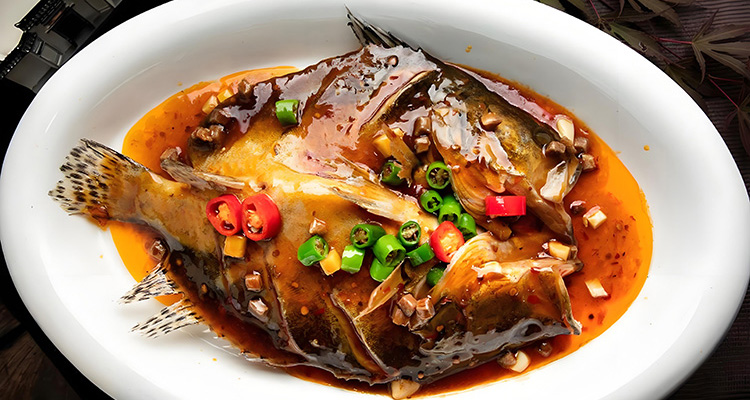Stinky Mandarin Fish: The Signature Flavor of Huizhou Cuisine
Imagine stepping into a rustic restaurant at the foot of Huangshan Mountain, surrounded by the aroma of local cooking. A powerful fermented scent fills the air — at first surprising, but soon intriguing. This is the unmistakable fragrance of Stinky Mandarin Fish, one of Anhui Province’s most iconic dishes. Though its name might sound intimidating, its rich umami flavor wins over anyone who tries it. This travel-friendly guide introduces the dish’s history, cultural meaning, taste, and where to experience it in Anhui.
1. Origin and History: A Happy Accident
The story of Stinky Mandarin Fish (Chou Guiyu) goes back more than 200 years. In the old days, fish merchants transporting precious mandarin fish inland to Huizhou faced spoilage during long journeys. To preserve the fish, they packed it layer by layer with salt in wooden barrels. Unexpectedly, the fish fermented — yet instead of spoiling, it developed a tighter texture, deeper flavor, and a distinct aroma. Local chefs refined the process, transforming the salted fish into one of Huizhou’s culinary treasures.
2. Cultural Significance: The Heart of Huizhou Banquets
In Huizhou culture, Stinky Mandarin Fish is not just a home dish; it’s a must-have for festivals, weddings, and family gatherings — a symbol of hospitality and respect. The dish’s vibrant color and spicy aroma represent warmth and welcome. For travelers, enjoying this dish in Hongcun, Xidi, or Shexian is more than a meal — it’s an immersion in Huizhou’s living culinary tradition.

3. Main Ingredients and Traditional Preparation
Authentic Huizhou Stinky Mandarin Fish depends on three things: fresh local fish, salt, and time.
- Fish: The best versions use local mandarin fish (also known as “Peach Blossom Fish”) for its delicate texture and few bones.
- Fermentation: Cleaned fish are coated inside and out with roasted Sichuan peppercorn and salt, then pressed into jars or barrels to ferment naturally for several days. This process develops amino acids and the distinctive, pungent fragrance while firming the meat.
- Cooking: The fermented fish is rinsed and pan-fried until golden, then braised with ginger, garlic, dried chili, Shaoxing wine, soy sauce, bamboo shoots, and minced pork. The sauce absorbs the fish’s aroma, creating a rich, layered flavor that defines Huizhou cuisine.
4. Flavor Profile and How to Eat
There’s a saying: “Smells bad, tastes good.” The strong aroma is purely sensory — the flavor is deeply savory and complex. The fish’s firm, flaky flesh releases an umami similar to cured ham or aged cheese. The bamboo shoots add freshness, the minced pork brings richness, and the thick sauce ties everything together.
Best eaten with rice, the dish’s sauce makes every bite fragrant and satisfying. Start with a small portion to adjust to the aroma, then savor its bold taste.

5. Travel Tips: Where and How to Try
- Be open-minded: The smell is part of the adventure — embrace it as a true cultural experience.
- Start small: Begin with a small bite, then enjoy more as you adjust to the flavor.
- Pair wisely: Balance the strong taste with light vegetable dishes or soups like Chrysanthemum Tofu Soup or sautéed greens.
- Where to eat: The best Stinky Mandarin Fish can be found in Hongcun, Xidi, and Shexian, where traditional Huizhou restaurants still ferment fish in wooden barrels by their doors.
- Salt level: The dish is naturally salty due to preservation — enjoy moderately.
6. Home Recipe for Adventurous Cooks
Want to try a simplified version at home?
- Use fresh mandarin fish or sea bass. Clean and pat dry.
- Coat inside and out with roasted peppercorns and salt (about 1:5 ratio), wrap, and refrigerate for 2–3 days for light fermentation.
- Rinse off the salt, pat dry, and pan-fry until golden.
- In a wok, sauté ginger, garlic, dried chili, minced pork, and sliced bamboo shoots. Add Shaoxing wine, soy sauce, a pinch of sugar, and water.
- Simmer the fish in the sauce for 10–15 minutes until thickened. Garnish with scallions and serve hot with rice.

7. Cultural Reflection: A Bold Taste of Huizhou’s Ingenuity
Stinky Mandarin Fish is a bold expression of Huizhou culinary wisdom — an acquired taste, but one worth embracing. On your Huangshan journey, try it at a local courtyard restaurant and let the unforgettable aroma and deep flavor become part of your travel story.
Dare to taste — the reward is a flavor you’ll remember for life.


